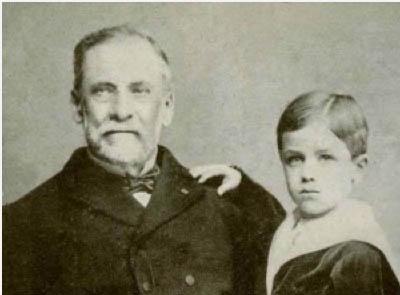-
Table of Contents
- 0. STORY PREFACE
- 1. RABIES - WHAT'S in a NAME?
- 2. RABIES in ANCIENT TIMES
- 3. WHAT IS RABIES?
- 4. LOUIS PASTEUR - EXPERIMENTER
- 5. LOUIS PASTEUR MEETS JOSEPH MEISTER
- 6. A TEEN HERO NAMED JEAN-BAPTISTE JUPILLE
- 7. LOUIS PASTEUR - WORLDWIDE BENEFACTOR
- 8. RABIES as a 21st-CENTURY PROBLEM
- 9. RABIES and ZOMBIES
The Pasteur Institute maintains historical documents and images from Pastuer's life. Here we see Louis Pasteur with Joseph Meister, the first human to receive Pasteur's rabies vaccination.
Pasteur’s lab, at the École Normale Supérieure, was located at 45 Rue d’Ulm in Paris. One of his closest collaborators and assistants was Pierre-Paul-Emile Roux (1853-1933).
It was Roux who discovered the first effective treatment for another dreaded disease which often struck children: Diphtheria. In addition, he worked on vaccines for tuberculosis, tetanus, pneumonia and syphilis.
By early July of 1885, Pasteur and his research team (including Roux) had developed a remarkably effective process of inoculating rabies-infected dogs.
Using a concoction of dried-spinal-chord material, harvested from rabid rabbits, the Paris-based researchers had saved the lives of fifty rabies-infected dogs.
What process did they use? Pasteur explains it in his 26 October 1885 report to the French Academy of Science:
The spinal cords of these rabbits are rabid throughout their length with a constancy in their virulence. If taking the greatest care possible to maintain purity one removes from these cords sections a few centimeters in length, and then suspends them in dry air, virulence slowly disappears until it finally disappears.
In other words, Pasteur believed that the virus in his desiccated jars was still alive but had vastly diminished potency, and thereby substantially reduced capacity, to cause the disease. But ... he couldn’t be sure about that, and he had no foolproof method to test his thinking (other than by application).
On the 6th of July, Pasteur had an unexpected visit from three people who lived in the Alsace region of France. Monsieur Theodore Vone owned a dog who had developed rabies. That dog, who’d become wild, bit Joseph Meister, Vone’s nine-year-old neighbor.
With the pair was Joseph’s distraught mother who knew her child would die if he developed rabies. That seemed likely since the lad had fourteen dog bites.

What was Pasteur to do?
He knew that his vaccine had saved the lives of fifty dogs, but he did not know whether it would work for a human. On the other hand, the boy would surely die if no one tried to help him before he developed the symptoms of rabies.
When he described how he resolved his dilemma - to inject or not inject Joseph with the rabies vaccine - Pasteur used these words (in English translation):
As the death of this child appeared inevitable, I decided, not without deep and severe unease, as one can well imagine, to try on Joseph Meister the procedure which had consistently worked in dogs.
Going forward with the first shot, Pasteur and two of his colleagues gave Joseph another twelve injections over the next ten days. Pasteur explains:
...on July 6, at 8 in the evening, sixty hours after the bites of July 4, and in the presence of Drs. Vulpian and Granter, one injected under a fold of skin in the right hypochondrium, one-half Pravaz syringe of spinal cord of a rabbit dead of rabies on June 21 and conserved since then in a flask of dry air, that is to say for 15 days.
What was the result?
Joseph survived! He was the first person to receive Pasteur’s injections which stopped the rabies virus (known as lyssavirus) in his body from progressing into a full-blown, fatal illness.
A few months later, a teenaged shepherd fought (and killed) a rabid dog to prevent younger children from being harmed. Jean-Baptiste Jupille, who was massively bitten himself, was from the same village where Pasteur had witnessed the branding-iron treatment so many decades before.
Could Pasteur’s vaccinations save the teen’s life?
-
Table of Contents
- 0. STORY PREFACE
- 1. RABIES - WHAT'S in a NAME?
- 2. RABIES in ANCIENT TIMES
- 3. WHAT IS RABIES?
- 4. LOUIS PASTEUR - EXPERIMENTER
- 5. LOUIS PASTEUR MEETS JOSEPH MEISTER
- 6. A TEEN HERO NAMED JEAN-BAPTISTE JUPILLE
- 7. LOUIS PASTEUR - WORLDWIDE BENEFACTOR
- 8. RABIES as a 21st-CENTURY PROBLEM
- 9. RABIES and ZOMBIES
Media Credits
The in-text image depicts a lithograph by F. Pirodon after a work created by L. L. Gsell. The English translation of the French caption is: "Rabies vaccination at Monsieur Pasteur's Laboratory [in Paris]." Original maintained by the Wellcome Trust in London. License: CC BY-SA 4.0


 Back
Back
 Next Chapter
Next Chapter

 Back
Back
 Next Chapter
Next Chapter

